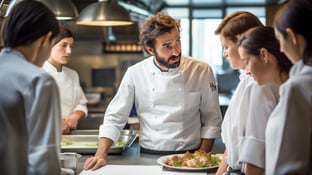As a restaurant owner, you don’t get many guarantees in life. Food costs are constantly rising. Customer preferences are shifting. Technology is changing the way we do everything. But here’s one thing you can always count on — health inspections.
At some point, at least once a year — or possibly as many as four times a year — your restaurant will be visited by a local health inspector. If the inspector finds even a minor food safety violation, it can come at a great cost to your business. That’s why it’s so important to have strategies in place for preventing and fixing food safety violations.
Let’s take a look at how the right procedures, training, and technology can help.
Why Food Safety Violations Matter for Restaurants
To be blunt, preventing food safety violations is a big deal. Obviously, failing health code inspections can lead to costly fines, restaurant closures, and even the loss of certain licenses. But food safety violations can also risk your reputation and the health of your customers.
Restaurant health code violations can lead to:
- Fines and legal actions for non-compliance
- Temporary or permanent restaurant shutdowns
- Suspension or revocation of certain food safety certifications
- A low letter grade on the U.S. Food and Drug Administration’s (FDA) A to C scale, which is displayed both in restaurant windows and through a publicly available online database
- Increased scrutiny and more frequent follow-up visits from health inspectors
- Heightened risk of foodborne illness
- Bad reviews, lost customer trust, and diminished brand reputation
The Most Common Food Safety Violations and How To Fix Them
Clearly, there’s a lot at stake here. So it’s important that you are familiar with the most common restaurant health code violations and that you’re prepared to fix them when they happen. Let’s dig a little deeper:
Improper Food Storage
Food that has been stored at the wrong temperature or in the wrong location can quickly become unsafe to eat. Improper food storage can lead to cross-contamination, spoilage, and mislabeling. Mislabeling may seem less serious, but it can lead to the use of incorrect ingredients, which can raise the risk of accidentally exposing diners to allergens.
How To Fix This Issue
- Store cold foods below 41°F at all times
- Use clear, dated labels and food-grade containers
- Store raw meats separately from, or below, ready-to-eat foods to avoid cross-contamination
- Monitor and record fridge and freezer temperatures 24/7 using wireless freezer monitoring technology like that available from Jolt
- Streamline inventory management using just-in-time delivery
- Rotate stock using the FIFO (first in, first out) method
Poor Handwashing & Hygiene Practices
Hand hygiene is one of the easiest ways to prevent the spread of germs. And yet, insufficient handwashing is one of the most common food safety violations in restaurants. It is absolutely vital to train and practice proper handwashing and hygiene, no matter how busy and fast-paced your kitchen is.
How To Fix This Issue
- Install conveniently located handwashing stations with soap, warm water, signage, and instructions
- Train your staff to wash hands often and thoroughly, specifically after handling raw food, using the restroom, or touching their own face or hair
- Enforce handwashing policies with regular oversight
- Supply gloves and hair coverings as needed — and ensure these items are used correctly
- Hold private interventions with employees who don’t meet the restaurant’s personal hygiene standards
Inadequate Cleaning & Sanitization of Equipment and Surfaces
Germs and bacteria can also spread on equipment and surfaces that aren’t properly cleaned.
Dirty equipment or surfaces can quickly spread bacteria. Cutting boards, prep tables, and counter tops can all become contaminated without proper sanitation. Dishes, utensils, and cookware can also spread bacteria if not washed properly and at a high enough temperature.
How To Fix This Issue
- Use safe and approved cleaning products
- Clean and sanitize surfaces that come into contact with food after every single use
- Post a cleaning schedule and use a daily cleaning checklist for your back-of-house staff
- Inspect dishwashers, icemakers, refrigerators, and other areas regularly to ensure they are properly cleaned
- Make sure that hand-washed dishes are cleaned at a minimum temperature of 110° F
Unsafe Food Handling & Preparation Practices
Improper food handling can spread germs. Improper prep methods like undercooking meat can contribute to foodborne illness. Both can sicken diners and lead to restaurant health code violations. Proper food handling and preparation procedures are essential.
How To Fix This Issue
- Require protective equipment including gloves, hair restraints, and face masks where appropriate
- Use cooking thermometers to ensure foods are cooked to the proper internal temperature
- Standardize food-handling procedures for cooling, freezing, and thawing foods
- Require the use of separate equipment and prep spaces for raw and ready-to-eat foods
Pest Infestations
Rodents and roaches are among the easiest ways to fail health inspections and lose customers. And unfortunately, pest infestations can be a stubborn problem, especially for city restaurants. But there are steps we can take to eliminate the things that attract pests, such as food waste, unsealed entry points, or improper storage.
How To Fix This Issue
- Hire a licensed pest control company to do regular inspections and extermination
- Locate and seal potential entry points including cracks, holes, and gaps near windows or doors
- Store foods and ingredients in well-sealed containers in off-the-ground shelving
- Clean and sanitize floors, walls, bathrooms, and drains regularly
- Remove trash frequently, use tightly sealed trash bins or dumpsters, and keep the trash collection area clean

Subscribe to Our Weekly Back of House Newsletter
Short and sweet summaries for busy restaurant operators. Subscribe to the Back of House newsletter to get updates delivered straight to your inbox.
Easy Ways to Prevent Food Safety Violations in Your Restaurant
Truly, the best way to prevent restaurant health code violations is to have a well-trained staff. Fortunately, there are some tech providers out there that can make food safety training extremely easy. For instance, Trust 20 provides online food handling courses and food handler certification for as low as $10-20 per person.
Trust 20 uses a combination of live courses, online training modules, and certification tests to help your staff learn the proper procedures for preventing food safety violations. Other recommended prevention measures include:
- Using daily, weekly and annual checklists to ensure compliance with the U.S. Food and Drug Administration’s (FDA) Retail Food Protection rules
- Implementing an advanced inventory management system to help reduce overstock, waste, and spoilage
- Assigning food safety leads for each shift
- Keeping your team up-to-date on local, state, and federal health code changes and training requirements
- Documenting daily cleaning schedules
- Adding real-time, cloud-based temperature monitoring technology to your refrigerators and freezers
What To Do If Your Restaurant Fails an Inspection
Inspection failures happen. It doesn’t have to be the end of the world, but you do have to act quickly. The exact actions that you must take will be up to the local authorities. In most cases, however, you will need to take the following steps:
- Fix all cited violations immediately
- Train or retrain staff in the specific areas where violations were found
- Document all of your corrective actions in anticipation of future reviews and inspections
- Keep organized records of your internal inspections
- Contact your local health department to schedule a re-inspection rather than waiting for them to contact you
- Anticipate extra scrutiny of your operations following an inspection failure
- Conduct routine training and retraining of staff to provide refreshers and prevent future inspection failures
How Back of House Can Help Your Restaurant With Food Safety
Training and tech can help you improve your food safety practices and procedures. But you have a lot of options. From online training programs and inventory management systems to compliance monitoring software, there are tons of resources out there that can help you.
I’m here to help you identify the best solutions for your needs. Reach out today and we can talk through your options.





